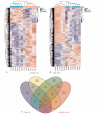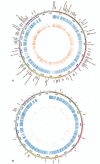Comparative gene expression profile and DNA methylation status in diabetic patients of Kazak and Han people
- PMID: 30200077
- PMCID: PMC6133596
- DOI: 10.1097/MD.0000000000011982
Comparative gene expression profile and DNA methylation status in diabetic patients of Kazak and Han people
Abstract
We attempted to investigate the mechanism and susceptibility genes for diabetes in Han and Kazak ethnic individuals.The abdominal omental adipose tissues were obtained from diabetic cases and healthy controls. The gene expression and methylation data were produced for Kazak and Han individuals, respectively, and analyzed by bioinformatics analysis.We obtained 921 differentially expressed genes (DEGs) in Han group and 1772 in Kazak group. DEGs in Han group were significantly related with type 2 diabetes mellitus, and biosynthesis of amino acids, while the DEGs specific to Kazak patients were significantly enriched in metabolism-related pathways such as carbon metabolism, propanoate metabolism, and 2-oxocarboxylic acid metabolism. Major facilitator superfamily domain containing 1 (MFSD1) was found to be a methylation associated gene at hypermethylation site of cg16289538 in Han group. Rho guanine nucleotide exchange factor 1 (ARHGEF1) was the susceptible gene corresponding to the methylation sites of cg18800192 and cg00759295 in Kazak group. ARHGEF1 was also a node in protein-protein interaction network and significantly enriched in hsa04270: vascular smooth muscle contraction pathways.The molecular mechanism of diabetes may be different in Han and Kazak patients. MFSD1 and ARHGEF1 may be the diabetes susceptible genes.
Conflict of interest statement
The authors have no conflicts of interest to disclose.
Figures





Similar articles
-
Ethnic differences in microRNA-375 expression level and DNA methylation status in type 2 diabetes of Han and Kazak populations.J Diabetes Res. 2014;2014:761938. doi: 10.1155/2014/761938. Epub 2014 Mar 11. J Diabetes Res. 2014. PMID: 24741571 Free PMC article.
-
Genetic polymorphism of peroxisome proliferator-activated receptor-gamma 2 Pro12Ala on ethnic susceptibility to diabetes in Uygur, Kazak and Han subjects.Clin Exp Pharmacol Physiol. 2008 Feb;35(2):187-91. doi: 10.1111/j.1440-1681.2007.04796.x. Epub 2007 Oct 17. Clin Exp Pharmacol Physiol. 2008. PMID: 17941898
-
Polymorphism of the ABO blood group genes in Han, Kazak and Uygur populations in the Silk Route of northwestern China.Tissue Antigens. 2000 Aug;56(2):136-42. doi: 10.1034/j.1399-0039.2000.560204.x. Tissue Antigens. 2000. PMID: 11019913
-
Correlations of ALDH2 rs671 and C12orf30 rs4767364 polymorphisms with increased risk and prognosis of esophageal squamous cell carcinoma in the Kazak and Han populations in Xinjiang province.J Clin Lab Anal. 2018 Feb;32(2):e22248. doi: 10.1002/jcla.22248. Epub 2017 May 2. J Clin Lab Anal. 2018. PMID: 28464297 Free PMC article.
-
TNNT2 Gene Polymorphisms are Associated with Susceptibility to Idiopathic Dilated Cardiomyopathy in Kazak and Han Chinese.Med Sci Monit. 2015 Nov 3;21:3343-7. doi: 10.12659/msm.894630. Med Sci Monit. 2015. PMID: 26525169 Free PMC article.
Cited by
-
Genome-wide meta-analysis associates GPSM1 with type 2 diabetes, a plausible gene involved in skeletal muscle function.J Hum Genet. 2020 Apr;65(4):411-420. doi: 10.1038/s10038-019-0720-3. Epub 2020 Jan 21. J Hum Genet. 2020. PMID: 31959871
-
DNA methylation and type 2 diabetes: a systematic review.Clin Epigenetics. 2024 May 16;16(1):67. doi: 10.1186/s13148-024-01670-6. Clin Epigenetics. 2024. PMID: 38755631 Free PMC article.
-
Overview of Transcriptomic Research on Type 2 Diabetes: Challenges and Perspectives.Genes (Basel). 2022 Jun 30;13(7):1176. doi: 10.3390/genes13071176. Genes (Basel). 2022. PMID: 35885959 Free PMC article. Review.
-
Omics Approaches in Adipose Tissue and Skeletal Muscle Addressing the Role of Extracellular Matrix in Obesity and Metabolic Dysfunction.Int J Mol Sci. 2021 Mar 9;22(5):2756. doi: 10.3390/ijms22052756. Int J Mol Sci. 2021. PMID: 33803198 Free PMC article. Review.
-
Identification of key genes in the pathogenesis of preeclampsia via bioinformatic analysis and experimental verification.Front Endocrinol (Lausanne). 2023 Jul 28;14:1190012. doi: 10.3389/fendo.2023.1190012. eCollection 2023. Front Endocrinol (Lausanne). 2023. PMID: 37576963 Free PMC article.
References
-
- Mellitus D. Diagnosis and classification of diabetes mellitus. Diabetes Care 2005;28:S37–42. - PubMed
-
- Cooke DW, Plotnick L. Type 1 diabetes mellitus in pediatrics. Pediatr Rev 2008;29:374–84. - PubMed
-
- Beagley J, Guariguata L, Weil C, et al. Global estimates of undiagnosed diabetes in adults. Diabetes Res Clin Pract 2014;103:150–60. - PubMed
-
- Wild S, Roglic G, Green A, et al. Global prevalence of diabetes estimates for the year 2000 and projections for 2030. Diabetes Care 2004;27:1047–53. - PubMed
-
- Despres J. Abdominal obesity as important component of insulin-resistance syndrome. Nutrition 1992;9:452–9. - PubMed
Publication types
MeSH terms
Substances
LinkOut - more resources
Full Text Sources
Other Literature Sources
Medical
Miscellaneous

